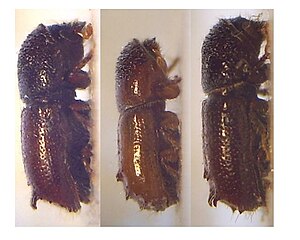Pityogenes
| Pityogenes | ||||||||||||
|---|---|---|---|---|---|---|---|---|---|---|---|---|

Example from left to right: male of Pityogenes calcaratus , P. calcographus , P. conjunctus , Imago. |
||||||||||||
| Systematics | ||||||||||||
|
||||||||||||
| Scientific name | ||||||||||||
| Pityogenes | ||||||||||||
| Bedel , 1888 |
The genus Pityogenes includes thirteen species of beetles in Europe that live on conifers . They are weevils from the subfamily of the bark beetles (Scolytinae). Since they set up their breeding systems in the bark of the host trees, they are counted among the bark breeders. There tend some species of the genus Pityogenes , in Germany particularly the engraver ( Pityogenes chalcographus ) to outbreaks in the past wood, storm or snow throws and -Brüchen, but also in standing by drought and insect damage or abiotic influences weakened conifers. These can then switch to completely healthy trees. From a forestry point of view , these bark beetles therefore have a very high damage potential in pure coniferous wood stands .
Generic description
The adults are between 1.5 and 3.5 millimeters long. They appear short and stocky. The uniformly arched pronotum is large, with cusps in front and conceals the head when viewed from above, its base is simply dotted or smooth and unrimmed, the front edge has a fine crown of cusps. Behind it has a smooth, flat longitudinal callus. The eyes are kidney-shaped. The antennae is five-membered and the antennae sutures are curved. The wing covers run parallel. The fall runs diagonally, its edge is covered with teeth in the male and with cusps in the female ( sexual dimorphism ). The second tooth on the fall in the male is a large hook tooth or a large conical tooth. The tip edge of the elytra is simple, it immediately embraces the abdomen . From the second sternite towards the end, the abdomen remains almost straight. The front rails are serrated on the outside. The third foot link is cylindrical.
Species in Europe
The following thirteen species are all found in Europe , although some species have not spread to certain areas of Europe. For more information, see the respective species.
- Pityogenes bistridentatus (Eichhoff, 1878)
- Pityogenes calcaratus (Eichhoff, 1878)
- Engraver or six-toothed spruce bark beetle ( Pityogenes chalcographus ) Linnaeus, 1761
- Small pine bark beetle ( Pityogenes conjunctus ) Reitter, 1887
- Pityogenes herbellae Strohmeyer, 1929
- Pityogenes irkutensis Eggers, 1910
- Pityogenes pennidens Reitter, 1889
- Pityogenes porifrons Eggers, 1933
- Four-toothed pine bark beetle ( Pityogenes quadridens ) Hartig, 1834
- Pityogenes saalasi Eggers, 1914
- Black pine bark beetle ( Pityogenes trepanatus ) Nördlinger, 1848
- Pityogenes irkutensis irkutensis Eggers, 1910
- Pityogenes irkutensis monacensis
Species outside of Europe
The list is not exhaustive:
- chestnut brown bark beetle Pityogenes hopkinsi (Swaine)
- Pityogenes mexicanus (Wood)
- Pityogenes plagiatus (LeConte), 1868
- Pityogenes quadridens (Hartig)
Forestry importance
Forestry damage is caused, among other things, by:
- the forced use of the infested trees often well before reaching the harvest age and
- the associated loss of wood, as the trees could continue to grow for several years ( loss of growth ),
- increased expenses due to irregular wood production (increased transport and processing costs ),
- Loss of quality of the wood through the subsequent penetration of fungi ( blue stain ) or other beetles such as longhorn beetles and / or other wood-eating insects (technical devaluation).
If the foci of infestation are not removed quickly, there can be mass reproductions that can reach enormous proportions ( Bavarian Forest National Park ). More information about the consequences under bark beetles .
Ecological importance
Due to the tendency to cause even completely healthy trees to die in the event of mass reproduction, the beetles can dissolve or loosen closed monocultures and give other tree species the opportunity to spread again through the incidence of light on the forest floor. They also create an abundant supply of standing and lying dead wood . In this way, they can indirectly create the conditions for increasing biodiversity .
Systematics
Synonyms
The following synonyms are known for the genus Pityogenes from the literature :
- Pityogenes Bedel, 1888 [Genus]
- Eggersia Lebedev, 1926
- Pityoceragenes Balachowsky 1947
swell
Individual evidence
- ^ Pityogenes (Bedel, 1888). Fauna Europaea, Version 1.3, April 19, 2007 , accessed on October 20, 2008 .
literature
- Sabine Green : Manual for the determination of the European bark beetle Verlag M. & H. Schaper, Hanover 1979, ISBN 3-7944-0103-4
- Edmund Reitter : Fauna Germanica - The beetles of the German Empire. Volume 5, KG Lutz, Stuttgart 1916
- Edmund Reitter: Fauna Germanica - The beetles of the German Empire. 5 volumes, Stuttgart KG Lutz 1908 - 1916, digital library volume 134, Directmedia Publishing GmbH, Berlin 2006, ISBN 3-89853-534-7
- Erwin Stresemann : Excursion fauna for the areas of the GDR and the FRG, Volume 2.1, invertebrates, insects-first part , people and knowledge Volkseigener Verlag, Berlin 1989, ISBN 3-06-012522-8
- Fritz Schwerdtfeger : The forest diseases. Textbook of forest pathology and forest protection. 4th, revised edition. Parey, Hamburg and Berlin 1981, ISBN 3-490-09116-7